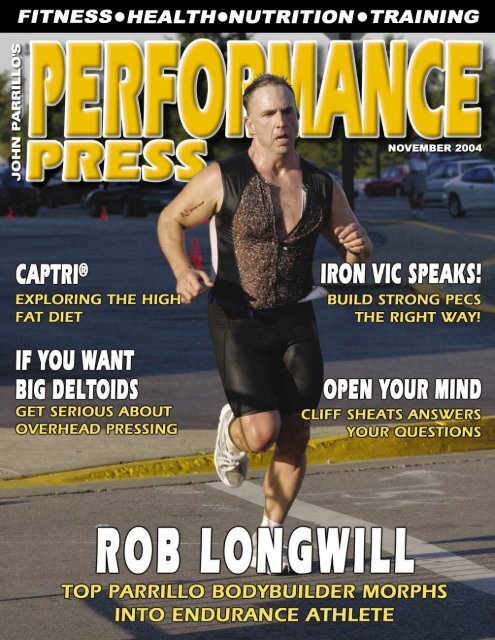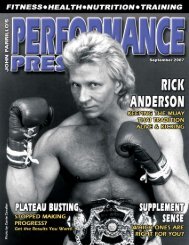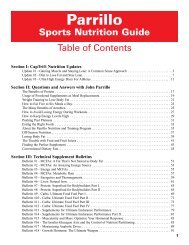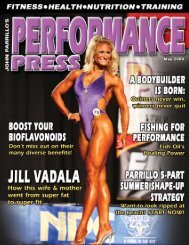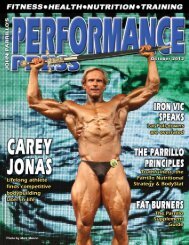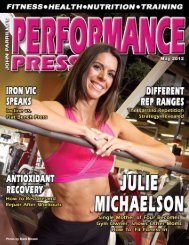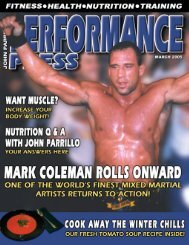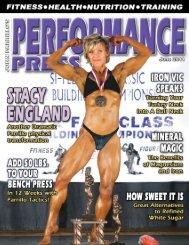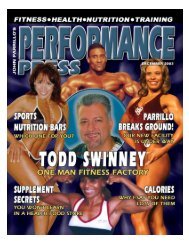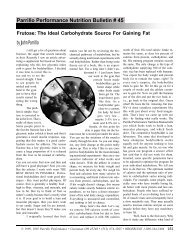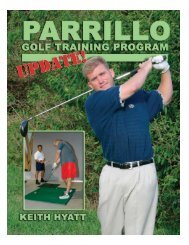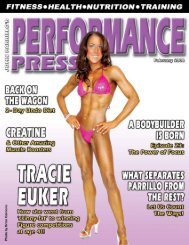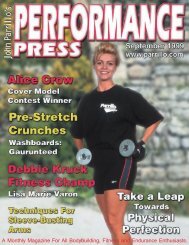November 6-7 - Parrillo Performance
November 6-7 - Parrillo Performance
November 6-7 - Parrillo Performance
Create successful ePaper yourself
Turn your PDF publications into a flip-book with our unique Google optimized e-Paper software.
January 22-23<br />
Level One Certification<br />
Cincinnati, Ohio<br />
<strong>November</strong> 6-7<br />
Master Level Certification<br />
Cincinnati, Ohio
JOHN PARRILLO’S PERFORMANCE PRESS<br />
Top <strong>Parrillo</strong> Bodybuilder<br />
Morphs Into Top Endurance Athlete<br />
By Marty Gallagher<br />
Often elite athletes have a<br />
successful career in a particular<br />
sport and after retiring<br />
take up a new athletic<br />
endeavor and quickly become<br />
adept at their latest undertaking.<br />
The elite know how to train hard<br />
and they know the level of effort<br />
and sacrifice required to make<br />
physical progress. They understand<br />
the commitment necessary to succeed<br />
and they take the approach<br />
(the discipline and work habits created<br />
in the old sport) and apply<br />
what they’ve learned to the new<br />
sport, obtaining spectacular results<br />
in a short time frame. Rob<br />
Longwill was a successful bodybuilder<br />
who retired from competition<br />
in 1995 and has since embarked<br />
on a competitive career as<br />
an endurance athlete. Rob lives in<br />
Danville, Kentucky and hung up his<br />
posing trunks in 1996. After a few<br />
years of sedentary living, he decided<br />
to “get off my butt” but<br />
wanted a new and fresh athletic<br />
challenge. He set off in an entirely<br />
new direction. “I competed in<br />
bodybuilding for five straight years<br />
and I won the AAU short class in<br />
1993. In 1995 I won the NPC state<br />
lightweight title.” Rob recalled.<br />
“When I won Mr. Kentucky I<br />
weighed 151-pounds and was in<br />
the absolute best shape of my life.<br />
At that point, to take it to the next<br />
level, I had to redouble my efforts<br />
in order to compete at the national<br />
level. I decided I didn’t want to do<br />
that and sought a new competitive<br />
outlet. I had lived the life of a fanatic<br />
bodybuilder for seven years<br />
and it was time for a change.”<br />
Rob had a life changing<br />
experience that<br />
unexpectedly exposed<br />
him to a whole new sport<br />
world, one he was only<br />
vaguely aware existed.<br />
In about that time, Rob had a life<br />
changing experience that unexpectedly<br />
exposed him to a whole new<br />
sport world, one he was only<br />
vaguely aware existed. “I got married<br />
to my wife Amy in 1996 and<br />
my priorities changed immediately:<br />
domestic life was great and my<br />
new wife is a fantastic cook: I discovered<br />
a whole new world of<br />
foods and food tastes.” Rob decided<br />
to focus more time and energy<br />
on expanding his personal<br />
training business. “To take my<br />
bodybuilding to the next level I<br />
would have to increase my commitment<br />
and my bodybuilding life<br />
was already taking up all my free<br />
time. I was weight training 4-5<br />
times a week, hitting cardio sometimes<br />
twice a day, my meal preparation<br />
took time, I had to sleep and<br />
work…Now I had a new wife and<br />
my time for bodybuilding was limited<br />
now.” Suddenly Rob had a<br />
wife and a domestic life and the<br />
laser-beam focus of the bodybuilding<br />
lifestyle was not appropriate.<br />
Rob devoted the next two years to<br />
building up his personal training<br />
business and settled in to a life of<br />
domestic bliss. “I discovered a<br />
whole new world of taste sensations.”<br />
Rob laughed. As a predictable<br />
result of loosening his diet restrictions,<br />
Mr. Kentucky soon began<br />
to more closely resemble Mr.<br />
Poppin’ Fresh, the pastry icon.<br />
“I was getting chubby and decided<br />
it was time to do something about<br />
it.” Rob said. “My wife Amy is a<br />
serious runner and has competed<br />
in several marathons. I got so fired<br />
up watching her compete that I<br />
decided to try my hand at some<br />
running events. All though my<br />
bodybuilding years I had done intense<br />
cardio and as a result my<br />
endurance was really good.”<br />
Bodybuilding had also taught Rob<br />
how to attain a low body fat percentile<br />
and as Rob eloquently<br />
stated it, “Naturally a person can<br />
run faster and further if they are<br />
carrying very little body fat.” A<br />
person 30-pounds overweight runs<br />
handicapped, carrying the equivalent<br />
of a pair of 15-pound dumb-<br />
www.parrillo.com 1-800-344-3404 <strong>Performance</strong> Press / <strong>November</strong> 2004 4
JOHN PARRILLO’S PERFORMANCE PRESS<br />
Sunday<br />
off<br />
Sessions typically last 30-60 minutes<br />
and are done using moderate<br />
poundage. Rep range is ‘moderate’<br />
and sets are executed at a<br />
rapid pace. “I am really pleased<br />
with the mesh I have obtained between<br />
weight training and my various<br />
aerobic activities. They seem<br />
to compliment each other.”<br />
Rob competes in each discipline: he swims,<br />
bikes and runs in competitive events; he also<br />
completes in triathlon events that link the three<br />
sports into one, requiring the athlete swim, bike<br />
and run all in the same event.<br />
bells as they race. By keeping his<br />
body fat low, around 10%, Rob<br />
minimizes the amount of body<br />
weight he has to haul around. Starting<br />
in 2001 Rob Longwill entered<br />
a staggering number of endurance<br />
events: thirty five and counting. “I<br />
discovered that in addition to running,<br />
I loved to bike and swim. It<br />
seemed only natural to begin competing<br />
in these sports. I really enjoy<br />
rotating cardio activity. I never<br />
do too much of any one of the three<br />
endurance disciplines. Each week<br />
I rotate them in order to make sure<br />
I improve in all three. I bike, I swim<br />
and I run and by doing all in the<br />
same week it keeps training fresh<br />
and exciting.” Rob competes in<br />
each discipline: he swims, bikes<br />
and runs in competitive events; he<br />
also completes in triathlon events<br />
that link the three sports into one,<br />
requiring the athlete swim, bike and<br />
run all in the same event.<br />
Weight Training Split<br />
Monday<br />
shoulders and arms<br />
Tuesday<br />
legs<br />
Wednesday<br />
chest and back<br />
Thursday<br />
no weight training<br />
Friday<br />
total body routine<br />
Saturday<br />
off<br />
In true <strong>Parrillo</strong> fashion, Rob<br />
Longwill eats plenty of calories in<br />
order to support the sheer volume<br />
of training he subjects himself to<br />
on a weekly basis. “I eat 4,000 to<br />
5,000 calories each and every day.<br />
For a 175-pound man, that might<br />
seem like a lot of calories but if I<br />
ate any fewer I would burn out. I<br />
could not train as hard or as long<br />
or as often as I do if I ate less. I<br />
burn an incredible amount of calories<br />
as a direct result of the all the<br />
miles and miles of running, biking<br />
and swimming I do each and every<br />
week – not to mention the caloric<br />
cost of the lifting – If I were<br />
to attempt to keep up my heavy<br />
workout schedule and eat fewer<br />
calories my body would rebel…my<br />
energy, my ability to recover<br />
quickly, my endurance and my<br />
speed would all suffer.” By eating<br />
lots of clean calories Rob avoids<br />
another common affliction<br />
amongst under-eating endurance<br />
athletes: the depressed immune<br />
system. If the human body is overworked<br />
and under-fed on a consistent<br />
basis, the immune system,<br />
the interconnected network of organs,<br />
glands and central nervous<br />
system, becomes fatigued and as<br />
a direct result loses its ability to fight<br />
5<br />
<strong>November</strong> 2004 / <strong>Performance</strong> Press 1-800-344-3404 www.parrillo.com
ROB LONGWILL<br />
off airborne flu, colds, infections<br />
and sickness. The body is unable<br />
to fend off germs and disease. By<br />
eating plenty of healing nutrients<br />
Rob Longwill can swim, bike, run<br />
and lift to his hearts content; with<br />
plenty of energy and with a reduced<br />
risk of damaging his body.<br />
Rob strives for balance in his life:<br />
he is soon to be a father and works<br />
a fulltime job. He still finds time to<br />
train and compete. “If for whatever<br />
reason my eating schedule is<br />
thrown off, my performance suffers<br />
as a direct result.” Rob uses<br />
<strong>Parrillo</strong> nutritional supplements<br />
every single day. “I use and recommend<br />
<strong>Parrillo</strong> Products to all my<br />
personal training clients.”<br />
Meal Schedule<br />
5:30 a.m.<br />
<strong>Parrillo</strong> Bar.<br />
Meal I<br />
8:30 a.m.<br />
8 egg white omelet red pepper,<br />
mushrooms.<br />
Meal II<br />
10:30 a.m.<br />
<strong>Parrillo</strong> Bar, oatmeal<br />
Meal III<br />
12: 00 p.m.<br />
Roasted chicken, large garden<br />
salad<br />
Rob drinks 80-100 ounces of water<br />
every day<br />
Cardio training split<br />
Monday<br />
5-10 kilometer morning run; afternoon<br />
bike ride for 30-40 miles.<br />
Tuesday<br />
1-mile swim; run twelve 440-yard<br />
dashes, 30-50 sec rest between.<br />
Wednesday<br />
Bike for 50-miles/run for 45 minutes.<br />
Thursday<br />
1-mile morning swim; easy bike<br />
ride two hours.<br />
Friday<br />
Easy bike ride or ten kilometer run.<br />
Saturday<br />
Compete.<br />
Sunday<br />
Rest.<br />
From 1989 to 1995 Rob competed<br />
in bodybuilding. In 1993 Rob won<br />
the Mr. Kentucky title. He repeated<br />
in 1993 and in 1995 Rob<br />
achieved his best ever condition<br />
when he captured the toughest<br />
physique competition in the state:<br />
the NPC Mr. Kentucky. “I<br />
weighed 151 at prejudging and 156<br />
at the evening show. I just missed<br />
winning the overall title. Without a<br />
doubt this was the leanest and most<br />
muscular condition I’ve ever<br />
achieved. “I met Amy one month<br />
after I won the Mr. Kentucky competition.<br />
She changed my life forever<br />
and for the better. She is a<br />
really good athlete and I naturally<br />
Meal IV<br />
4:00 p.m.<br />
Almonds (23 total), <strong>Parrillo</strong> Optimized<br />
Whey.<br />
Meal V<br />
6:00 p.m.<br />
Fish, garden salad, steamed<br />
squash.<br />
Rob strives for balance in his life: he is soon to<br />
be a father and works a fulltime job. He still finds<br />
time to train and compete.<br />
www.parrillo.com 1-800-344-3404 <strong>Performance</strong> Press / <strong>November</strong> 2004 6
ROB LONGWILL<br />
fell in with her when she went on<br />
runs.” When Amy qualified for the<br />
Boston Marathon, Rob began entering<br />
endurance competitions.<br />
Since 2001 he has competed in<br />
thirty-five events: 5K and 10K<br />
road races, half marathons, marathons,<br />
triathlons and Half Iron Man<br />
events. When a local boy from<br />
Rob’s area was killed in Iraq Rob<br />
decided to show his solidarity with<br />
the fallen Marine in an unusual<br />
way. “On April 24 th 2004 I ran my<br />
first marathon and ran it while carrying<br />
an American Flag for the<br />
entire 26-miles. I did this to honor<br />
a local soldier killed in Iraq named<br />
Nick Dieruff.” The flag was 3 foot<br />
by 5 foot and Rob ran 26-miles<br />
carrying the flag on a flag pole<br />
continually waving it for four hours<br />
and twenty-four minutes. Eight<br />
days later Rob ran a second marathon,<br />
this one in Cincinnati and<br />
again he carried the flag honoring<br />
Dieruff’s sacrifice. “My legs were<br />
still dead from the previous week<br />
but I went through with the race<br />
anyway. Unfortunately the<br />
weather didn’t cooperate. For the<br />
first 20-miles it rained.” Rob related.<br />
The flag gained considerable<br />
weight as a result of getting wet<br />
yet Rob ran this race in an amazing<br />
time of four hours and twentyeight<br />
minutes.<br />
Rob’s immediate goal is to qualify<br />
for the Hawaiian Iron Man. The<br />
full-blown Hawaii Iron Man<br />
Triathlon requires participants to<br />
swim 2.4-miles, bike for 112-miles<br />
and finish with a 26.2 mile run. In<br />
order to qualify for the Hawaiian<br />
Iron Man Rob will have to compete<br />
in a “Half Iron Man” and<br />
swim 1.3 miles, bike 56-miles and<br />
run for 13.1 miles. He must do it in<br />
5-hours and fifteen minutes or less.<br />
“My best time for the half-Iron<br />
Man is 5-hours and 38-minutes so<br />
I need to drop my times across the<br />
board in all three legs of the race.<br />
I feel confident that I can qualify<br />
in the near future.” We wouldn’t<br />
bet against this 35-year old. Amy<br />
recently informed Rob that he was<br />
soon to be a father. “Life keeps<br />
getting better and better. We are<br />
extremely excited about becoming<br />
parents.” The new Longwill child<br />
should possess some awesome<br />
genetics.<br />
7 <strong>November</strong> 2004 / <strong>Performance</strong> Press 1-800-344-3404 www.parrillo.com
JOHN PARRILLO’S PERFORMANCE PRESS<br />
My own contest had come and<br />
gone, and reaching the best shape<br />
of my life had only been good<br />
enough for third place in the<br />
Heavyweights. Of course, at 203<br />
pounds I would have been more<br />
competitive in a weight class called<br />
‘Not-quite Heavyweight,” but at<br />
this writing the NPC has no such<br />
division. The men who beat me<br />
were so much larger as to finally<br />
make me come to terms with the<br />
fact that perhaps God put me on<br />
this earth to be a writer and a<br />
coach, rather than a big jacked-up<br />
freak. In fact, I am still bruised<br />
form being jostled by several sets<br />
of 21-inch arms during prejudging.<br />
After allowing myself a couple<br />
days to wallow in self-pity and<br />
endless bowls of Frankenberry<br />
cereal (my kids had already finished<br />
the Count Chocula and<br />
BooBerry in the big three-pack box<br />
of monster cereals), it was time to<br />
redirect my focus toward Randy.<br />
Genetically, this kid had the tools<br />
to be a real champion and rack up<br />
some nice titles, and I knew I could<br />
guide him to it. The first step was<br />
going to be improving his overall<br />
shape and symmetry by bringing<br />
up a couple muscle groups of his<br />
that could stand to be thicker and<br />
fuller.<br />
“Weak muscle groups can grow if given a fighting chance.”<br />
9 <strong>November</strong> 2004 / <strong>Performance</strong> Press 1-800-344-3404 www.parrillo.com
A BODYBUILDER IS BORN<br />
“Let me explain the Harris Priority<br />
Principle,” I began, addressing my<br />
young charge Randy.<br />
“Um, don’t you mean the Weider<br />
Priority Principle?” he corrected<br />
me.<br />
“Weider?” I scratched my head.<br />
“Hmm, the name does sound<br />
vaguely familiar. But who cares<br />
about him, I have been the trainer<br />
of champions since, well, about<br />
twelve years now.” Randy was<br />
silent, allowing this display of pomposity<br />
to continue.<br />
“You need to bring up your arms,<br />
your calves, and your upper chest.<br />
So for the next four months, they<br />
will all receive special attention, or<br />
priority, in your training.”<br />
“I train all of those really hard now,<br />
though,” he responded, the usual<br />
defensiveness creeping into his<br />
voice.<br />
“I never said you didn’t, Junior,” I<br />
assured him. “But training hard<br />
isn’t always enough, especially<br />
when it comes to a stubborn<br />
bodypart. You also need to train<br />
smart, and in this case it means giving<br />
your weaker muscle groups a<br />
fighting chance.”<br />
“Okay,” he shrugged, “so how do I<br />
do that?”<br />
“I’m glad you asked,” I smiled, and<br />
opened up my training journal. I<br />
tore out a page from the back where<br />
I had outlined a new training split<br />
for Randy. I handed it over, and<br />
here’s what was on it:<br />
“Prioritization can drastically speed up the rate of progress.”<br />
Monday:<br />
Arms and calves<br />
Tuesday:<br />
Legs<br />
Thursday:<br />
Chest and shoulders<br />
Friday:<br />
Back<br />
Saturday:<br />
Arms and calves (blood-volume<br />
training)<br />
Randy appeared puzzled, as he often<br />
did when trying to make sense<br />
out of my suggestions, so I explained<br />
the method to my madness.<br />
“Arms and calves are going to be<br />
trained heavy on Mondays after a<br />
full day of rest. The reps will be<br />
6-10 for arms, 8-12 for calves, and<br />
you will be paying special attention<br />
to the Harris Peak Contraction<br />
Principle by flexing the target<br />
muscle at the end of every rep.”<br />
“Don’t you mean the Weider...”<br />
“Silence!” I barked. “On Saturday<br />
you will train arms and calves<br />
again, but this time the reps will be<br />
12-20 for arms, and 20-50 for<br />
calves. The reps will be a constant,<br />
piston-like motion with no<br />
pause at the beginning or end.<br />
Some people these days refer to<br />
this as ‘blood-volume’ training, but<br />
it’s really nothing more than what<br />
we used to call the Harris Flush-<br />
www.parrillo.com 1-800-344-3404 <strong>Performance</strong> Press / <strong>November</strong> 2004<br />
10
A BODYBUILDER IS BORN<br />
ing Principle back in the old days<br />
of Larry Scott and Arnold.”<br />
Randy looked at me sideways.<br />
“You weren’t even born when<br />
Larry Scott was Mr. Olympia,<br />
come on now.”<br />
“I will not tolerate this infernal insolence!”<br />
He was just lucky I<br />
wasn’t like the cruel Kung Fu master<br />
Pai Mei from Kill Bill, Volume<br />
2. You talked back to that bearded<br />
little Chinese dude and he would<br />
pluck your eyeball right out the<br />
socket. I don’t even know how to<br />
pluck eyebrows, which is why my<br />
wife has that done at a salon now<br />
after I botched the job that one<br />
time. It’s not my fault I never finished<br />
Beauty School.<br />
“Hitting your arms and calves twice<br />
a week with two different styles<br />
of training is going to get them<br />
growing faster than they have for<br />
a very long time, bucko,” I promised<br />
him. “Now for your upper<br />
chest...”<br />
“We already do inclines,” he reminded<br />
me.<br />
“Right, but for the next twelve<br />
weeks, all you will be doing for<br />
your chest is incline movements.<br />
Incline barbell presses, incline flyes<br />
and cable crossovers, and incline<br />
dumbbell presses,” I informed him.<br />
“What about my middle and lower<br />
chest?” he whined.<br />
“What about them? Listen, in over<br />
twenty years of astutely studying<br />
physiques, I have yet to see anyone<br />
with a great upper chest and a<br />
weak middle and lower chest. 999<br />
times out of a thousand it’s just the<br />
opposite. The rest of your chest<br />
isn’t going to wither away, fear<br />
not. But you can’t really improve<br />
your upper chest unless you devote<br />
all of your energy to it for a period<br />
of time.” Randy nodded in acquiescence.<br />
“In the end, great symmetry<br />
goes a long way.”<br />
“We also need to make sure you<br />
are fueling this muscle growth,” I<br />
continued. “During this specialization<br />
period I want you taking in at<br />
least two grams of protein per<br />
pound of bodyweight, and three to<br />
four grams of carbohydrates. Get<br />
the extra protein and carbs from<br />
<strong>Parrillo</strong> Hi-Protein and Optimized<br />
Whey powders, liver aminos, and<br />
the nutrition bars. I also want you<br />
taking six capsules of the Muscle<br />
Aminos, the branched-chain ones,<br />
three times a day on an empty<br />
stomach. One of those times will<br />
be during your workout. I want to<br />
see you gain ten pounds in that<br />
time, and I want almost all of that<br />
to be pure muscle. You’re young<br />
and your genetics are good, I know<br />
you can do it.”<br />
“You really think I can bring my<br />
arms, calves, and upper chest up<br />
enough to notice in just three<br />
months?”<br />
“The whole point of specializing is<br />
accomplishing something in a short<br />
time that would normally take<br />
much longer. I estimate that we<br />
can get more growth out of those<br />
areas in three months than you<br />
would have seen in at least a year<br />
doing what you have been doing.”<br />
Randy was grinning, obviously excited<br />
about the coming months.<br />
“I feel like it’s just so crazy that it<br />
might work. Thanks, Ron.”<br />
“What can I say?” I laughed. “I<br />
am a man of Principles!”<br />
P.S. No disrespect here was meant<br />
to Joe Weider, the Master Blaster<br />
and Trainer of Champions since<br />
1939 – a full six decades before<br />
Ron Harris popped out of his<br />
mama’s womb and started flexing!<br />
11 <strong>November</strong> 2004 / <strong>Performance</strong> Press 1-800-344-3404 www.parrillo.com
JOHN PARRILLO’S PERFORMANCE PRESS<br />
By John <strong>Parrillo</strong><br />
Over the last two or three years<br />
several “new” dietary strategies<br />
have been advanced that are specifically<br />
designed to help bodybuilders<br />
get extremely lean for contests.<br />
These diets have in common a<br />
fairly high protein intake, around 25<br />
to 30 percent of calories. Another<br />
common feature is that they advocate<br />
reducing carbohydrate content<br />
in favor of increasing dietary fat<br />
consumption. Some of these plans<br />
call for limiting carbs to 30 to 50<br />
grams per day, or even less, and<br />
providing around 70 percent of<br />
calories from fat. This regimen is<br />
carried out over a five day (or so)<br />
course to deliberately induce ketosis<br />
and a fat-burning metabolism,<br />
to promote the use of stored body<br />
fat as energy. This is followed by<br />
two or three days of carbing up to<br />
provide an anabolic growth spurt.<br />
Not only does dietary<br />
fat contribute more to<br />
fat stores than protein<br />
or carbohydrate (1-13),<br />
but dietary fat<br />
(especially saturated<br />
fat) increases your<br />
cholesterol level and<br />
your risk for heart<br />
disease.<br />
Another program is more moderate,<br />
suggesting a diet of 30 percent<br />
protein, 40 percent carbs, and 30<br />
percent fat, without cycling. There<br />
is a lot of science and theory behind<br />
these diets, although the highfat<br />
recommendation is quite controversial.<br />
Without getting too<br />
bogged down in the biochemical<br />
details, the fundamental idea behind<br />
these approaches is to reduce carbohydrate<br />
intake in order to reduce<br />
insulin levels. Insulin is a potent inhibitor<br />
of lipolysis, or fat breakdown.<br />
By reducing insulin levels,<br />
you can take the brakes off fat metabolism<br />
and encourage the use of<br />
stored body fat for energy.<br />
In my work with bodybuilders, I<br />
have found that reducing carbs<br />
does indeed help to promote fat<br />
loss, especially in people who have<br />
a hard time getting lean. I don’t<br />
have a problem with carb reduction<br />
– as long as it’s done right (I’ll<br />
get to that in a moment). But what<br />
I have a problem with is that with<br />
high fat diets, the dietary fat is<br />
VERY prone to be stored as body<br />
fat. Several studies have demonstrated<br />
that body fat percentage is<br />
more highly determined by dietary<br />
fat intake than by calorie intake<br />
(1,2,3,4,6,8,9,10). Not only does dietary<br />
fat contribute more to fat<br />
stores than protein or carbohydrate<br />
(1-13), but dietary fat (especially<br />
long chain saturated fat) increases<br />
your cholesterol level and your risk<br />
for heart disease.<br />
Back to carbs for a moment: A<br />
problem with the very low carb<br />
approach is that energy levels fall<br />
dramatically. Anaerobic exercise,<br />
such as weight lifting, is fueled almost<br />
exclusively by carbs. Fat cannot<br />
be used as an anaerobic energy<br />
source; it can only be oxidized<br />
aerobically. Therefore, strength<br />
and energy levels fall dramatically<br />
without carbs. This results in more<br />
muscle catabolism (breakdown and<br />
www.parrillo.com 1-800-344-3404 <strong>Performance</strong> Press / <strong>November</strong> 2004<br />
14
JOHN PARRILLO’S PERFORMANCE PRESS<br />
You can rest assured that CapTri® is the only fat<br />
you’ll find in our supplement bars.<br />
loss), as the muscles turn to<br />
branched chain amino acids as fuel.<br />
In addition, low carbohydrate diets<br />
have been found to reduce thyroid<br />
hormone level, which is one of the<br />
chief controllers of metabolic rate.<br />
If you’re familiar with my work at<br />
all, you know that I advocate, in<br />
general, a diet high in protein, high<br />
in complex carbohydrates, and<br />
very low in fat. I agree that hardtraining<br />
athletes need more protein<br />
than sedentary people, at least one<br />
gram to 1.5 grams or more per<br />
pound of body weight per day. This<br />
is a good general guideline, especially<br />
during weight gain. As you<br />
decrease calories to lose fat, it helps<br />
to increase this amount to as much<br />
as 1.5 to 2 grams or more per<br />
pound of bodyweight per day. The<br />
higher dietary protein intake helps<br />
prevent catabolism of muscle protein<br />
during energy-restricted diets.<br />
Next, you should allot 5 to 10 percent<br />
of your daily calories to come<br />
from fat. The remainder of your<br />
calories come from complex carbohydrates,<br />
which I divide into<br />
starches (potatoes, rice, beans, and<br />
so forth) and fibrous carbs (vegetables<br />
and salad greens). By combining<br />
protein and fibrous vegetables<br />
with your starch at each<br />
meal you can greatly slow the rate<br />
of release of glucose into the bloodstream.<br />
This in turn decreases insulin<br />
levels, taking the brakes off<br />
fat metabolism. You will find that<br />
by proper food combining you can<br />
stimulate a powerful fat burning<br />
effect without eliminating too many<br />
carbs from your diet.<br />
But because carbohydrate reduction<br />
is such a powerful tool for fat<br />
loss, I’ve developed an approach<br />
to low-carb dieting that allows you<br />
to utilize the power of the low carb<br />
diet without resorting to using regular<br />
fat as a food source. Instead of<br />
regular fat, you use CapTri®, a<br />
specially engineered fat with a<br />
unique molecular structure which<br />
causes it to follow a different metabolic<br />
route than regular fats (14,15).<br />
It behaves more like a carbohydrate<br />
in the body, except that it<br />
doesn’t increase insulin levels. This<br />
means you can use CapTri® in<br />
place of carbs to decrease insulin<br />
levels and shift your metabolism<br />
into a fat-burning mode. This is<br />
very similar to the strategy of the<br />
high fat diets except without relying<br />
on conventional fat as an energy<br />
source. In short, CapTri® lets<br />
you reap the benefits of the high<br />
fat approach without the problems<br />
that go along with conventional dietary<br />
fat.<br />
To use CapTri® for fat loss, continue<br />
to keep your protein intake<br />
high at about 1.5 to 2 grams or<br />
more per pound of body weight per<br />
day, then reduce starchy carbohydrate<br />
intake and provide an equivalent<br />
number of calories from Cap-<br />
Tri® while making sure you still eat<br />
plenty of fibrous carbs.For example,<br />
if you normally consume<br />
300 grams of carbs per day (1200<br />
calories worth), reduce that to 150<br />
grams per day and add 5 tablespoons<br />
of CapTri® per day (pro-<br />
“I’ve developed an approach to low-carb<br />
dieting that allows you to utilize the power of<br />
the low carb diet without resorting to using<br />
regular fat as a food source. Instead of regular<br />
fat, you use CapTri®, a specially engineered fat<br />
with a unique molecular structure which<br />
causes it to follow a different metabolic route<br />
than regular fats (14,15).”<br />
15Antione <strong>November</strong> Roseanne 2004 / <strong>Performance</strong> Press Meral 1-800-344-3404 Robert www.parrillo.com Monica
EXPLORING THE HIGH FAT DIET WITH CAPTRI®<br />
viding 570 calories). By reducing<br />
carbs and always combining your<br />
starches with protein, vegetables,<br />
and CapTri® at each meal, you will<br />
dramatically reduce insulin levels<br />
and maximize fat loss. One more<br />
point: Unlike conventional fats,<br />
CapTri® also works well during<br />
weight gain because it doesn’t contribute<br />
to fat stores (14,15).<br />
References<br />
1. Horton TJ, Drougas H,<br />
Brachey A, Reed GW,<br />
Peters JC, and Hill JO.<br />
1995. Fat and carbohydrate<br />
overfeeding. American<br />
Journal of Clinical<br />
Nutrition 62: 19-29.<br />
2. Flatt JP. 1988. Importance<br />
of nutrient humans: different<br />
effects on energy<br />
storage. balance in body<br />
weight regulation. Diabetes/Metabolism<br />
Reviews 4:<br />
571-581.<br />
3. Flatt JP. 1995. Use and<br />
storage of carbohydrate<br />
and fat. American Journal<br />
of Clinical Nutrition 61:<br />
952s-959s.<br />
4. Hill JO, Peters JC, Reed<br />
GW, Schlundt DG, Sharp T,<br />
and Greene HL. 1991.<br />
Nutrient balance in humans:<br />
effects of diet<br />
composition. American<br />
Journal of Clinical<br />
Nutrition 54: 10-17.<br />
5. Hill JO, Drougas H, and<br />
Peters JC. 1993. Obesity<br />
treatment: can diet composition<br />
play a role? Annals<br />
of Internal Medicine 119:<br />
694-697.<br />
6. Bray GA. 1987. Obesity -<br />
a disease of nutrient or<br />
energy balance? Nutrition<br />
Reviews 45: 33-43.<br />
7. Thomas CD, Peters JC,<br />
Reed GW, Abumrad NN,<br />
Sun M, and Hill JO. 1992.<br />
Nutrient balance and<br />
energy expenditure during<br />
ad libitum feeding of highfat<br />
and high-carbohydrate<br />
diets in humans. American<br />
Journal of Clinical<br />
Nutrition 55: 934-942.<br />
8. Astrup A, Buemann B,<br />
Western, Toubro S, Raben<br />
A, and Christensen NJ.<br />
1994. Obesity as an<br />
adaptation to a high-fat<br />
diet: evidence from a<br />
cross-sectional study.<br />
American Journal of<br />
Clinical Nutrition 59: 350-<br />
355.<br />
9. Schutz Y, Flatt JP, and<br />
Jequier E. 1989. Failure of<br />
dietary fat intake to<br />
promote fat oxidation: a<br />
factor favoring the development<br />
of obesity. American<br />
Journal of Clinical<br />
Nutrition 50: 307-314.<br />
10. Miller WC, Niederpruem<br />
MG, Wallace JP, and<br />
Lindeman AK. 1994.<br />
Dietary fat, sugar, and fiber<br />
predict percent body fat<br />
content. Journal of the<br />
American Dietetic Association<br />
94: 612-615.<br />
11. Tucker LA and Kano MJ.<br />
1992. Dietary fat and body<br />
fat: a multivariate study of<br />
205 adult females. American<br />
Journal of Clinical<br />
Nutrition 56: 616-622.<br />
12. Acheson KJ, Flatt JP, and<br />
Jequier E. 1982. Glycogen<br />
synthesis versus lipogenesis<br />
after a 500 gram<br />
carbohydrate meal in man.<br />
Metabolism 31: 1234-<br />
1240.<br />
13. Flatt JP. 1987. Dietary fat,<br />
carbohydrate balance, and<br />
weight maintenance:<br />
effects of exercise.<br />
American Journal of<br />
Clinical Nutrition 45: 296-<br />
306.<br />
14. Baba N, Bracco EF, and<br />
Hashim SA. 1982. Enhanced<br />
thermogenesis and<br />
diminished deposition of fat<br />
in response to overfeeding<br />
with diet containing medium<br />
chain triglyceride.<br />
American Journal of<br />
Clinical Nutrition 35: 678-<br />
682.<br />
15. Bach AC and Babayan<br />
VK. 1982. Medium chain<br />
triglycerides: an update.<br />
American Journal of<br />
Clinical Nutrition 36: 950-<br />
962.<br />
www.parrillo.com 1-800-344-3404 <strong>Performance</strong> Press / <strong>November</strong> 2004 16
JOHN PARRILLO’S PERFORMANCE PRESS<br />
As I go around the country speaking<br />
to various groups, I always allow<br />
for a question and answer session,<br />
one of the most productive<br />
parts of any presentation. In this<br />
month’s column, I’d like to share<br />
with you some of the most pressing<br />
concerns people like you have<br />
about nutrition and exercise. Here<br />
are some of the questions, with my<br />
responses, that I’m most often<br />
asked.<br />
Does the metabolism slow<br />
down with age?<br />
Not really. What changes with<br />
many older people is their exercise<br />
and eating habits. They exercise<br />
less and eat less, and the metabolism<br />
slows down as a result. By<br />
eating the proper foods, exercising,<br />
and gradually increasing calories,<br />
anyone, regardless of age, can<br />
have a healthy metabolism.<br />
Can I drink alcohol on the<br />
<strong>Parrillo</strong> Nutrition Program or<br />
the Lean Bodies Program?<br />
Alcohol has a dehydrating effect<br />
on the body; in other words, it upsets<br />
your body’s water balance.<br />
Alcohol is also full of simple sugars,<br />
which are converted easily into<br />
body fat (weight loss). Additionally,<br />
studies have shown that moderate<br />
drinking can elevate blood pressure.<br />
I recommend that you stay<br />
away from alcohol until you have<br />
reached your body fat percentage<br />
goal. Then you may use it on a limited<br />
basis.<br />
How many lipotropic supplements<br />
should I take each day?<br />
If you decide to add these supplements<br />
to the <strong>Parrillo</strong> Nutrition Program,<br />
take one with each meal or,<br />
to make taking them more convenient,<br />
take two lipotropics with<br />
breakfast and two more with dinner.<br />
Always check with your doctor<br />
first before taking any supplements.<br />
What about sodium? How<br />
much, if any, should I take in?<br />
Sodium or salt is a very controversial<br />
subject. To begin with, it is important<br />
to understand that sodium<br />
is an important mineral found in our<br />
bones, in the fluids surrounding our<br />
cells, and in the cardiovascular system.<br />
Sodium works together with<br />
potassium to assist nerve stimulation<br />
and regulate water balance. It<br />
is also involved in carbohydrate<br />
absorption. The average person<br />
requires a minimum of one-tenth<br />
of a teaspoon of salt a day. An athlete<br />
who sweats profusely needs<br />
more, about a teaspoon a day. Both<br />
the <strong>Parrillo</strong> Nutrition Program and<br />
the Lean Bodies Program provides<br />
a healthy ratio of potassium to sodium;<br />
at least 2 to 1.<br />
Is low blood sugar correctable?<br />
Yes, Ninety-five percent (95%) of<br />
all low blood sugar (hypoglycemia)<br />
is reactive, meaning that it is<br />
caused by factors within our control,<br />
such as diet. The other 5 percent<br />
of hypoglycemia is caused by<br />
medical problems such as pancreatic<br />
tumors.<br />
If I take MCT oil, won’t I gain<br />
fat?<br />
No. MCT oil is burned so rapidly<br />
for energy that it is difficult for the<br />
body to store it as fat.<br />
I gained weight the first week.<br />
Is that a bad sign?<br />
People who start the program with<br />
slow metabolisms, usually due to a<br />
history of roller-coaster dieting,<br />
typically gain some weight the first<br />
week. An initial gain, however, is<br />
the first step toward building your<br />
metabolism. Once your body starts<br />
becoming reoriented toward processing<br />
food, you will burn significant<br />
amounts of body fat (weight<br />
loss).<br />
Are commercially frozen egg<br />
whites, such as those in the<br />
grocer’s freezer, allowed?<br />
No. These products do not have<br />
the nutrient value of real egg<br />
whites. Additionally, they contain<br />
chemical additives. The only time<br />
17 <strong>November</strong> 2004 / <strong>Performance</strong> Press 1-800-344-3404 www.parrillo.com
EXPLORING THE HIGH FAT DIET WITH CAPTRI®<br />
If you decide to add<br />
lipotropic supplements<br />
to the <strong>Parrillo</strong> Nutrition<br />
Program, take one with<br />
each meal or, to make<br />
taking them more<br />
convenient, take two<br />
lipotropics with breakfast<br />
and two more with dinner.<br />
you should eat these products is<br />
when you are traveling and cannot<br />
get real egg whites.<br />
If I eliminate bananas, how will<br />
I get my dietary potassium?<br />
You will get this vital mineral from<br />
potatoes (a starchy carbohydrate),<br />
which contain at least as much<br />
potassium as bananas.<br />
I’m not really fond of oatmeal.<br />
What should I eat for breakfast?<br />
You definitely do not have to eat<br />
oatmeal. There are many choices<br />
of whole grains on the program to<br />
choose for breakfast, including<br />
kasha, barley, corn grits, and shredded<br />
wheat.<br />
You recommend that we drink<br />
eight to 10 large glasses of water<br />
daily on the program. Can I<br />
replace some of that water with<br />
diet soft drinks?<br />
Consider this: More than 70 percent<br />
of an eight-ounce glass of water<br />
is absorbed by the stomach, and<br />
only 15 to 20 percent of the same<br />
amount of soda is absorbed. Plus,<br />
diet soft drinks contain artificial<br />
sweeteners and other chemicals.<br />
How these additives are used by<br />
the body is unclear. Look at it this<br />
way. Would you wash your clothes<br />
in soda pop? Then why clean your<br />
body that way? Remember - water<br />
is the universal solvent.<br />
How much water should I drink<br />
each day?<br />
Eight to 10 large glasses a day, especially<br />
if you are active.<br />
If Omega-3s are such important<br />
nutrients, shouldn’t I take<br />
omega-3 supplements?<br />
As long as you include cold water,<br />
oceangoing, boney fish in your<br />
meal plans, you will get enough of<br />
the omega-3 fatty acids. In fact,<br />
just three ounces of fish a day supplies<br />
an ample amount of this protective<br />
nutrient.<br />
I’ve heard that vitamins begin<br />
to degrade in nutrient value the<br />
minute the bottle is opened. Is<br />
this true?<br />
It depends on how you store your<br />
vitamins. Vitamins are a food, and<br />
like foods, they are subject to spoilage.<br />
Store your vitamins carefully<br />
and always keep their lids on tight.<br />
What does “enriched” mean?<br />
Enriching is the replacement of<br />
nutrients in food which have been<br />
previously lost due to processing.<br />
The biggest problem with enriched<br />
foods is that only a few nutrients<br />
are added back in. Additionally,<br />
those replacement nutrients are<br />
synthetic and therefore not of the<br />
same nutritional value as those<br />
originally found in the food.<br />
Can I cook with safflower oil or<br />
any of the essential fatty acids<br />
allowed on the program?<br />
Cooking causes oxidation – or<br />
breakdown – of the nutrients in the<br />
fats; For that reason, do not heat<br />
or cook the fats.<br />
www.parrillo.com 1-800-344-3404 <strong>Performance</strong> Press / <strong>November</strong> 2004 18
JOHN PARRILLO’S PERFORMANCE PRESS<br />
By Andre “Duke” Nukem<br />
I recently had a serious <strong>Parrillo</strong><br />
trainee ask me a question that I<br />
thought put a lot of things about<br />
shoulder training into clear perspective,<br />
“Andre,” the lady asked during<br />
an intense training session, “If<br />
you were shipwrecked on a desert<br />
island and could only do one exercise<br />
for your shoulders, what would<br />
it be?” I laughed and asked if I<br />
could have some equipment with<br />
me on the island – she graciously<br />
agreed. “Overhead presses.” I<br />
said. “I firmly believe that presses<br />
are the best single delt exercise and<br />
the ability to press heavy poundage<br />
overhead is fastest way to develop<br />
big, powerful, shapely shoulders.”<br />
She asked if that meant a<br />
person had to rep 225-pounds in the<br />
seated press-behind-the-neck,<br />
“No,” I replied, “regardless of<br />
where you are at currently in terms<br />
of pressing strength, regardless if<br />
you can press 50-pounds or 300-<br />
pounds, find a way to increase<br />
press poundage you’ll significantly<br />
increase the size of your shoulder<br />
melons.” Further, I elaborated, if<br />
you currently don’t do any overhead<br />
shoulder pressing and add<br />
them to your lifting routine you’ll<br />
experience the best shoulder gains<br />
of your life. I asked why she<br />
phrased this question in such a<br />
unique fashion and she admitted<br />
she was an avid watcher of the TV<br />
show Survivor. Give me a barbell,<br />
two adjustable dumbbells, an exercise<br />
bench and I’d be good to go<br />
on that deserted island. A squat<br />
rack would be nice. The overhead<br />
press is a compound multi-joint exercise<br />
that forces the three deltoid<br />
heads (along with triceps) to work<br />
hard in order to complete the movement.<br />
Pressing requires all the<br />
muscles of the shoulder girdle make<br />
a unified, synchronized muscular<br />
effort. This allows the bodybuilder<br />
to handle heavy poundage relative<br />
to other deltoid exercises.<br />
There are two overhead press<br />
variations: the front press and the<br />
press-behind-the-neck. Front<br />
pressing is done with a relatively<br />
narrow grip while a wide grip is<br />
used in the press-behind-the-neck.<br />
These two press variants blast deltoids<br />
into submission with a thoroughness<br />
that is unobtainable using<br />
any other shoulder exercise.<br />
Not that there is anything wrong<br />
with the various lateral raise variations:<br />
if they are done correctly (and<br />
that’s a big ‘if’) lateral raises isolate<br />
and stimulate each of the three<br />
deltoid heads one at a time. The<br />
problem lies in proper performance.<br />
More often than not, lateral<br />
raises devolve into lateral<br />
heaves and momentum and rebound<br />
nullifies effectiveness. By<br />
heaving a weight at the start of a<br />
lateral raise the bodybuilder is able<br />
to use significantly more weight –<br />
but at what cost? The isolation attributes<br />
are totally lost when heave<br />
laterals are used; muscle stimulation<br />
spreads to the trapezius and<br />
while a strict lateral raise is an ex-<br />
19<br />
<strong>November</strong> 2004 / <strong>Performance</strong> Press 1-800-344-3404 www.parrillo.com
WANT BIG DELTOIDS?<br />
There are two overhead press variations: the front press<br />
and the press-behind-the-neck. Front pressing is done<br />
with a relatively narrow grip while a wide grip is used in<br />
the press-behind-the-neck. These two press variants<br />
blast deltoids into submission with a thoroughness that<br />
is unobtainable using any other shoulder exercise.<br />
cellent delt isolation exercise, a<br />
heavy cheat lateral raise is a poor<br />
delt/trap exercise. Lateral raises<br />
need be done strictly and should<br />
always be done after heavy overhead<br />
pressing otherwise you prefatigue<br />
the delts and zap them of<br />
the strength needed to push heavy<br />
poundage overhead. It might be<br />
appropriate to take a minute and<br />
go over correct technique for both<br />
front press and the press-behindthe-neck.<br />
(PBN) With each of<br />
these two major press variations<br />
there exist two possibilities: you can<br />
press poundage either standing or<br />
seated. In addition you can perform<br />
the front press with either a barbell<br />
or dumbbells. The PBN is<br />
strictly a barbell exercise.<br />
OVERHEAD FRONT<br />
PRESS:<br />
There are two ways to do this exercise:<br />
standing or seated. In the<br />
standing press you ‘clean’ the<br />
poundage from the floor before<br />
doing your press reps. Alternatively<br />
you may place a loaded barbell on<br />
a squat rack and set the rack supports<br />
slightly below shoulder height.<br />
Dip under the bar, stand erect<br />
(clearing the support pins) lock<br />
your knees and begin pressing. You<br />
can do the clean and press with<br />
either a barbell or a pair of dumbbells.<br />
The clean can be tricky and<br />
great care need be taken pulling the<br />
weight from the floor to the shoulders.<br />
Set the loaded bar or a pair<br />
of dumbbells at your feet and take<br />
a grip slightly wider than your<br />
shoulders. Your feet are approximately<br />
one foot apart and with a<br />
tight, flexed back, pull the weight<br />
straight up, at the top of the pull dip<br />
your knees, snap your wrists over<br />
and rack the weight on the shoulders.<br />
Once the weight is cleaned,<br />
flex the legs and glutes and push<br />
the weight straight up. A tiny bit of<br />
backbend is okay but avoid radical<br />
backbend as this is potentially injurious.<br />
The more upright you stay<br />
the more difficult and beneficial the<br />
exercise becomes. One each successive<br />
repetition, lower the weight<br />
slowly and push it upward explosively.<br />
Make sure you lock the<br />
weight out completely and hold the<br />
lock-out for a full second before<br />
unlocking and lowering the poundage.<br />
Do not bounce the weight off<br />
your shoulders in order to get a rebound<br />
as this makes the exercise<br />
easier. If you prefer seated presses,<br />
you can use dumbbells. Clean the<br />
bells and sit down carefully. The<br />
seated front press using a barbell<br />
is performed inside a power rack<br />
with the pins set slightly lower than<br />
the start position. The lifter takes a<br />
seat, squeezes under the bar and<br />
inhales which causes the barbell to<br />
clear the pins. Once the bar is clear<br />
of the pins begin the press reps.<br />
www.parrillo.com 1-800-344-3404 <strong>Performance</strong> Press / <strong>November</strong> 2004 20
WANT BIG DELTOIDS?<br />
Regardless the style used, make<br />
sure not to hit your head when lowering<br />
the weight.<br />
PRESS BEHIND THE<br />
NECK:<br />
Done with a barbell this exercise<br />
may be performed standing or<br />
seated. To perform the standing<br />
version, place the poundage on a<br />
squat rack. Grip is determined by<br />
your wingspan: the idea is to assume<br />
a grip that allows you to push<br />
from a position where your forearms<br />
are vertical to your upper<br />
arms when the upper arms are parallel<br />
to the floor. Put another way:<br />
the front press grip should be<br />
slightly wider than your shoulders<br />
and the PBN grip is roughly 3 to 6-<br />
inches wider yet on each side. After<br />
assuming your grip, dip under a<br />
barbell set on the squat rack, stand<br />
erect clearing the racks; step back,<br />
lock out the legs and glutes before<br />
pushing the bar upward from behind<br />
the head. At completion of<br />
each rep, lock out hard and hold<br />
the lockout before lowering the bar<br />
slowly. Again don’t hit your skull<br />
on the way down. You might have<br />
to push your head slightly forward<br />
as you push up and lower. On all<br />
subsequent repetitions lower the<br />
barbell only to the bottom of the ear<br />
lobes before pressing upward. Do<br />
not allow the bar to settle on the<br />
shoulder between the individual<br />
repetitions. This technique keeps<br />
continual tension on the deltoids and<br />
avoids undue stress on the rotator<br />
cuffs. Please keep in mind that<br />
some individuals experience shoulder<br />
joint stress from the PBN so<br />
add poundage slowly and take your<br />
time. Build up the weight gradually.<br />
Elite gyms will have a specially designed<br />
PBN bench but usage realistically<br />
requires a spotter. The<br />
problem with the seated PBN is if<br />
you get stuck without a spotter you<br />
have to stand erect and jerk the<br />
weight over your head in order to<br />
get it off your back; cumbersome<br />
and potentially dangerous.<br />
PRESS AHEAD:<br />
I like to start my shoulder routine<br />
off with 3-5 sets of seated or standing<br />
front presses. Some days I use<br />
dumbbells and other times a barbell.<br />
You can handle slightly more<br />
poundage using a barbell but dumbbells<br />
force each arm to carry an<br />
equal burden. Mix and match. I alternate<br />
between the front press<br />
done taking a weight off a squat<br />
rack (and using a little layback on<br />
each rep) and cleaning a pair of<br />
dumbbells and doing my presses<br />
standing or seated in stricter fashion.<br />
I will rotate seated and standing<br />
as the spirit moves me. I like to<br />
pyramid up to a top set of five to<br />
eight reps and once I’ve finished<br />
doing my front presses I’ll drop<br />
poundage off the barbell and continue<br />
with strict standing behindthe-neck-presses.<br />
I prefer to do the<br />
PBN standing. I take the barbell<br />
out of a squat rack and use a little<br />
leg drive to get the first rep started.<br />
My shoulders are fatigued from the<br />
front presses so I do my PBN super-strict<br />
for 2-3 sets using lighter<br />
weight and higher repetitions. After<br />
front presses and behind-theneck-presses<br />
I finish off my deltoid<br />
routine with 3-4 sets of front<br />
and lateral raises. Please slash the<br />
lateral raise poundage and lift –<br />
don’t heave – the bells upward. It<br />
is advisable to give shoulders their<br />
very own training day. Most trainees<br />
will place shoulder training behind<br />
chest training and the deltoids,<br />
heavily involved in bench press<br />
variations, are never at 100% by<br />
the time you’ve finished benching.<br />
Better to break shoulder training out<br />
from behind pectorals and give<br />
them a separate training day so you<br />
can work with fresh deltoids at full<br />
strength. Work the hell out of your<br />
overhead pressing and you’ll end<br />
up with melon-sized deltoids. Remember:<br />
increased strength<br />
equates to increased muscle size,<br />
always and forever. Concentrate<br />
on improving press poundage and<br />
sure as God made little green<br />
apples those deltoids will grow<br />
faster than fertilized weeds after a<br />
rainstorm!<br />
PS: After a savage workout I always<br />
take a double serving of<br />
<strong>Parrillo</strong> 50-50 Plus. This potent<br />
<strong>Parrillo</strong> powder provides shockedblasted<br />
muscle exactly what they<br />
need to heal, recover and grow.<br />
Check out the nutritional statistics<br />
of a double dose of 50-50 Plus:<br />
protein 41 grams, slow-release carbohydrates<br />
34 grams, fat and sugar<br />
– zero, calories 300. As soon as the<br />
final set of my workout is done I<br />
reach into my gym bag to retrieve<br />
my Tupperware shaker loaded with<br />
50-50 Plus. I walk to the water<br />
fountain and activate the potent<br />
powder with 12-ounces of cold water.<br />
Simply shake and consume the<br />
delicious mixture and bang! You’ve<br />
provided muscles targeted in the<br />
workout with exactly what they<br />
need to grow! Call our toll free<br />
number to order a canister today.<br />
1-800-344-3404<br />
21 <strong>November</strong> 2004 / <strong>Performance</strong> Press 1-800-344-3404 www.parrillo.com
JOHN PARRILLO’S PERFORMANCE PRESS<br />
Vic,<br />
What is the best exercise for<br />
bringing out the inner pectoral?<br />
I say incline flyes and my training<br />
partner says cable crossovers<br />
done with a pause – how about<br />
pec deck? Could you settle this<br />
argument?<br />
Ronnie and Tracy<br />
Here’s an idea: quit wasting time<br />
on puny little exercises done with<br />
light weights. Put training time recovered<br />
from jettisoning shaping<br />
exercises into obtaining a monster<br />
bench press. I’ve never seen a guy<br />
with a 400-pound bench press that<br />
didn’t have great pec development.<br />
(though I’ve seen lot’s of 400-plus<br />
bench pressers that were fat as pigs<br />
– but that’s a different issue).<br />
Trainers like you and Tracy love<br />
itty-bitty precise exercises that use<br />
ligh poundage and are performed<br />
for endless reps and countless sets.<br />
You pump up your show muscles<br />
and run to the nearest mirror where<br />
you primp and preen and marvel to<br />
each other how fabulous your 13-<br />
inch arms and a 39-inch chest look<br />
compared to their normal 12.5/38.5-<br />
inch pre-workout non-pumped<br />
state. Guys like you and Tracy love<br />
to talk about ‘contour, delineation,<br />
fiber clarity and separation’ but who<br />
cares about all that jive? A person<br />
could easily acquire the equivalent<br />
of your chest development from a<br />
pair of good mosquito bites. Here’s<br />
an idea: what ever you bench press<br />
direct all your efforts and energies<br />
towards adding another 50-pounds.<br />
If you have a 250 bench press work<br />
towards 300…300 then work towards<br />
350. In your case let’s get<br />
your 185-pound bench press up to<br />
225. The point being that there is a<br />
direct correlation between significant<br />
strength increases and significant<br />
muscle size increases. I’m<br />
talking about getting super strong<br />
in the core lifts not increasing your<br />
cable crossover poundage from 15-<br />
pounds to 20. To gain significant<br />
muscle size you have to become<br />
significantly stronger. Work the<br />
heck out of the basic exercises:<br />
bench press, incline bench press,<br />
overhead press, squat (ever heard<br />
of that one Ronnie?) deadlift, barbell<br />
row, press behind the neck and<br />
power clean – tough exercises done<br />
strictly with barbells and dumbbells.<br />
I’m under no illusions that you’ll<br />
ever do what I suggest; guys like<br />
you and Tracy are on an eternal<br />
expert search for confirmation,<br />
someone to tell you that what you<br />
are doing is great because you are<br />
going to do it regardless. Don’t be<br />
afraid to try new routines but don’t<br />
forget the basics!<br />
By John <strong>Parrillo</strong><br />
23 <strong>November</strong> 2004 / <strong>Performance</strong> Press 1-800-344-3404 www.parrillo.com
IRON VIC SPEAKS<br />
To gain significant muscle size you have to<br />
become significantly stronger. Work the heck out<br />
of the basic exercises: bench press, incline<br />
bench press, overhead press, squat, deadlift,<br />
barbell row, press behind the neck and power<br />
clean – tough exercises done strictly with<br />
barbells and dumbbells.<br />
Iron Vic,<br />
A friend and I were watching that<br />
old Burt Reynolds movie, ‘The<br />
Cannonball Run’ and my buddy<br />
told me that you had actually<br />
competed in the real race back<br />
in the early seventies – any truth<br />
to that?<br />
Steve T.<br />
Dearborn, MI<br />
Have I no secrets? How did your<br />
friend know about that? The Cannonball<br />
Sea-to-Shining-Sea crosscountry<br />
road race was dreamed up<br />
by Brock Yates (then editor of Car<br />
& Driver magazine) and a bunch<br />
of other gear heads over drinks at<br />
a bar back in 1970. The idea was<br />
that everyone would start at a bar<br />
on the east coast and whoever arrived<br />
first at a coastline bar on the<br />
west coast would be the champion.<br />
No money or prizes, just a cheap<br />
plastic trophy and bragging rights.<br />
I actually entered the second Cannonball<br />
on a whim and got spanked<br />
really bad. I made two mistakes,<br />
first I thought the ideal car would<br />
be my 426-mopar Dodge hemi<br />
charger that delivered 500-horsepower<br />
and could cruise all day at<br />
120-mph. What it couldn’t do was<br />
cruise by a gas station and I ended<br />
up making nineteen gas stops during<br />
my 3,453 mile voyage from hell.<br />
My second mistake was taking a<br />
nationally ranked Olympic lifter<br />
along as my co-pilot. This was back<br />
in the fear & loathing days of<br />
booze, Marlboros and illicit drugs.<br />
My buddy could clean and jerk 450<br />
and seemed normal enough but was<br />
I ever wrong! He thought that it<br />
would be a good idea to stay awake<br />
for four straight days of driving and<br />
he got a hold of some ‘goon juice,’<br />
a liquid amphetamine that lifters<br />
used to jack themselves up with<br />
back in those days. He kept swigging<br />
goon juice from a bottle he said<br />
contained orange juice. By the<br />
middle of day one he was out of<br />
his mind; by the end of day two he<br />
was hallucinating and holding conversations<br />
with himself. It all came<br />
to a head on the third day when he<br />
devolved into a schizophrenic raving<br />
lunatic with dried white drool<br />
surrounding a mouth that never<br />
stopped yapping, yelping and howling.<br />
I had to let him drive for a<br />
couple hours so I could get some<br />
sleep and I awoke to find he had<br />
left Route 66 and was cutting<br />
across the desert on a single lane<br />
gravel road. “It’s a shortcut!” He<br />
raved. He had chugged a bottle of<br />
Rebel Yell whiskey to ‘mellow his<br />
edge’ and we got into a fistfight<br />
when I tried to force him to pull<br />
over. He ran the vehicle through a<br />
Navaho Indian reservation and<br />
while we struggled for the steering<br />
wheel he almost ran over a 16-year<br />
old Indian boy on a bike and overturned<br />
the Dodge. Bad scene…we<br />
spent a day locked up in a tribal reservation<br />
jail. A lynch mob of enraged<br />
Native Americans tried to<br />
bust him out of jail to string him up.<br />
Dan Gurney won that year in a 4-<br />
litre Ferrari Daytona and basketball<br />
immortal Wilt “The Stilt” Chamberlain<br />
blew everyone’s mind by<br />
www.parrillo.com 1-800-344-3404 <strong>Performance</strong> Press / <strong>November</strong> 2004<br />
24
IRON VIC SPEAKS<br />
taking 4 th place driving a Rolls<br />
Royce convertible with a playboy<br />
bunny as co-pilot. The next year I<br />
went to Hertz rent-a-car and leased<br />
a Shelby Mustang. Hertz had this<br />
hair-brained idea and actually<br />
rented Shelby 289-271 horsepower<br />
Mustangs as a promotion in conjunction<br />
with Ford. That was stupid;<br />
I rented one for a week and<br />
enlisted a SCCA sports car driver<br />
who trained at the gym I managed<br />
at the time. I stuffed the back seat<br />
with food and we used empty<br />
Gatorade bottles to save rest stop<br />
time. We finished 7 th . I had learned<br />
a valuable lesson: never get into a<br />
fist fight with an amphetaminecrazed<br />
steroid-monster drug addict<br />
while he is drunk and driving a 500-<br />
horsepower muscle car 130 miles<br />
per hour down a narrow gravel road<br />
The most effective and accurate way to gauge<br />
your progress and eliminate all of the guesswork<br />
is with the <strong>Parrillo</strong> Body Stat Kit.<br />
riddled with potholes and pedestrians<br />
walking down both sides of the<br />
road…nothing but bad can come of<br />
it.<br />
Iron Vic,<br />
What is the best way to get ripped<br />
and what is a reasonable length<br />
of time to do it in?<br />
John didn’t just pull this number out<br />
of his glute cleft one slow afternoon,<br />
he arrived at it after preparing<br />
hundreds (literally) of bodybuilders<br />
for contests. The beauty of his<br />
approach is its effective simplicity:<br />
gain or lose more than 1-pound per<br />
hundred pounds bodyweight and<br />
run the risk of adding body fat or<br />
losing muscle mass.<br />
“I have always liked my old<br />
buddy John <strong>Parrillo</strong>’s<br />
common sense approach to<br />
gaining mass and getting<br />
shredded: add or lose body<br />
weight at the rate of 1 pound<br />
per week per hundred pounds<br />
of body weight.”<br />
Randy<br />
Idaho<br />
I have always liked my old buddy<br />
John <strong>Parrillo</strong>’s commonsense approach<br />
to gaining mass and getting<br />
shredded: add or lose body weight<br />
at the rate of 1-pound per week per<br />
hundred pounds of body weight. If<br />
you weigh 150 and are looking to<br />
add mass, do so at the rate of 1.5<br />
pounds of body weight per week.<br />
If you weigh 150 and looking to get<br />
sliced-and-diced, lose fat at the rate<br />
of 1.5 pounds of body weight per<br />
week. If you weighed 250 the<br />
weekly number would climb to 2.5<br />
pounds of body weight per week.<br />
The most effective and accurate<br />
way to gauge your progress and<br />
eliminate all of the guesswork is<br />
with the <strong>Parrillo</strong> Body Stat Kit.<br />
It provides everything you need to<br />
calculate your ratio of bodyfat to<br />
lean mass, percent of bodyfat and<br />
your pounds of lean mass. The process<br />
is extremely simple too. You<br />
simply take all of the instructed<br />
measurements with the provided<br />
skinfold caliper, input the measurements<br />
on our Body Stat sheet and<br />
follow the simple calculations.<br />
Compare your results week to<br />
week and make the required adjustments<br />
to reach your desired results.<br />
25 <strong>November</strong> 2004 / <strong>Performance</strong> Press 1-800-344-3404 www.parrillo.com
PRSRT STD<br />
U.S. POSTAGE<br />
PAID<br />
CINCINNATI, OH<br />
PERMIT NO. 855


